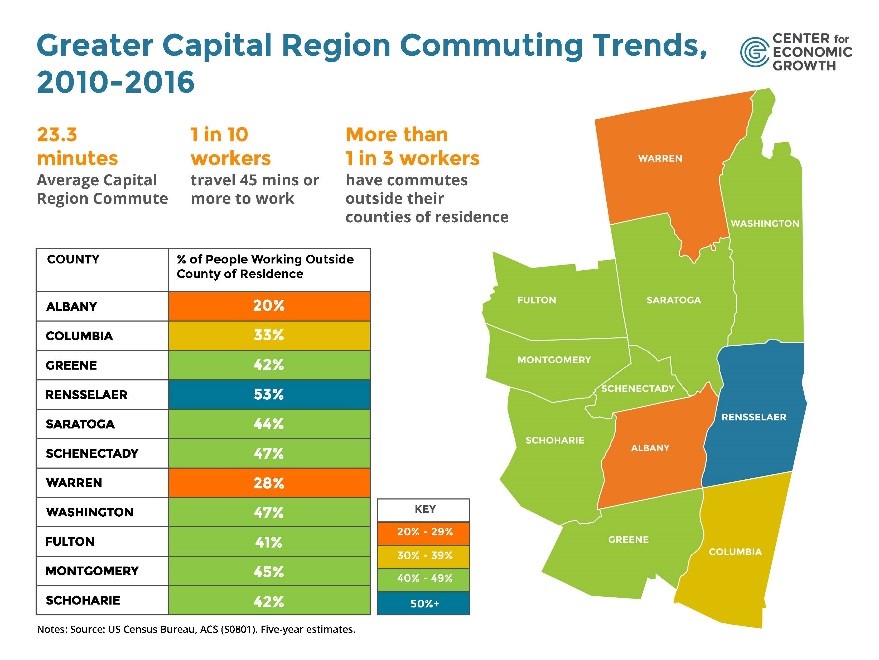Commuting Trends Highlight Growing Regionalization of the Capital Region
Residents of the Capital Region and its outlying counties are increasingly crossing county and state lines – and traveling longer – to get to work. At the same time, greater shares of workers in the region’s neighboring counties in Massachusetts and Vermont are likewise commuting across state lines. Taken together, these commuting trends support a broader and more inclusive definition of the region.

Intra-State Commuting Patterns
Between 2010 and 2016, the Capital Region experienced a 2.7 percent increase in people working outside their counties of residence. In 2016, that meant 195,553, or 37.1 percent, of workers in the eight-county region were working in a New York State county other than the one in which they lived, compared to 36.6 percent in 2010, according to a Center for Economic Growth (CEG) analysis of U.S. Census Bureau five-year estimates.
Although the total number of workers in the region’s three outlying New York State counties (Fulton, Montgomery, and Schoharie) declined between 2010 and 2016, their share of workers commuting outside of their counties of residence rose by 0.5 percentage points to 38.4 percent. While that does not necessarily mean those workers were exclusively commuting to the Capital Region, it is where there have been more job opportunities for them.
Notable regional intra-state commuting trends during the 2010-2016 period included:
3 percent increase in workers commuting out of Albany County.
1 percent increase in workers commuting out of Fulton County.
5 percent increase in workers commuting out of Warren County.
Saratoga and Washington counties were alone in the Greater Capital Region in seeing increases in workers commuting within their counties or residence (7.7 percent and 4.7 percent, respectively).

Inter-State Commuting Patterns
Between 2010 and 2016, the Capital Region experienced a 3.7 percent increase in workers commuting to another state. However, that increase was proportionate with the overall growth of the region’s workforce, leaving its share of out-of-state commuters unchanged since 2010 at 1.9 percent.
Notable regional inter-state commuting trends during the 2010-2016 period included:
7 percent increase in Rensselaer County workers commuting out of state.
8 percent increase in Washington County workers commuting out of state.
7 percent increase in Berkshire County workers commuting out of state.
Long-Distance and Super Commuters
In 2016, the average commute time in the Capital Region was 23.3 minutes. However, at the same time the Capital Region that year had an estimated 50,334 long-distance commuters who traveled 45 to 89 minutes to work – up 7 percent from 2011. Growth among Capital Region super commuters, who travel 90 minutes or more to work, was even more robust, increasing by 21.6 percent. In the eight-county region, Greene County had the greatest share of long-distance commuters (11.8 percent) and Washington County had the greatest share of super commuters (2.9 percent).

CEG’s Economic Development Efforts
These commuting patterns bolster CEG’s industry attraction efforts because companies interested in relocating are sensitive to the availability of talent in a region. By influencing the size of the region at the number of workers within it, this “commutershed” makes the Capital Region more attractive to relocating companies. Whether responding to a request for proposals (RFP), attending at dozens of industry trade conferences worldwide, CEG is sending the message that the Capital Region has a sizeable skilled labor force with workers who will both literally and figuratively go that extra mile to help a company thrive.
Don’t miss these insights into the trends that are shaping the Capital Region’s economy. Sign up for CEG’s e-news and follow us on:














